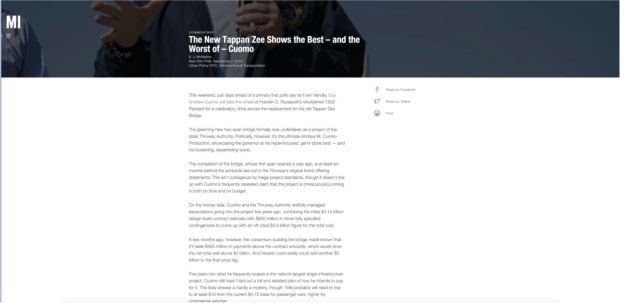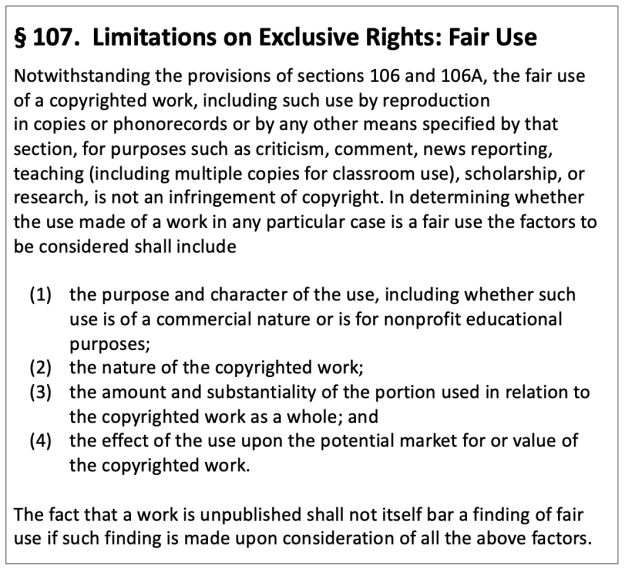A think tank fellow publishes an opinion piece in The New York Post that includes a fetching photo of New York Governor Andrew Cuomo. (Mind you, this is two years before the governor's daily pandemic press conferences would make him, somewhat unexpectedly, the object of massive "crushing," and routinely leave a number of otherwise sensible citizens in an Empire State of Mind.) The think tank reposts the article on its website, along with a version of the photo that is cropped and modified so substantially that even the governor's biggest fans could not possibly recognize him. (You definitely can't make out his jacked guns.) The photographer sues. Copyright infringement or fair use?
Here are the details.
Plaintiff Richard Harbus is a photographer who earns his living licensing his photos for editorial use. In 2018, Harbus licensed a photo depicting New York Governor Andrew Cuomo standing in front of the Governor Mario Cuomo Bridge (née the Tappan Zee bridge) to The New York Post to accompany an article written by a fellow at the defendant Manhattan Institute for Policy Research (the "Institute"). Later, the Institute included the article in its online archive (in a section labeled "Publications: Commentary"), along with thousands of others. As you can see from the screen shot below, the Institute substantially cropped Harbus' photo (you can only see Cuomo's hands and part of his chest) and darkened and further obscured the photo (presumably so readers could more easily see the overlaid headline and byline in a white font).

After he learned of this use, Harbus sued the Institute for copyright infringement. Judge Ramos in the Southern District of New York granted the Institute's motion to dismiss under Federal Rule 12(b)(6) on fair use grounds. Here's a quick rundown of the court's analysis of the statutory factors.

The Purpose and Character of the Use. The court agreed with the Institute that its use was transformative. At the outset, the court found that Harbus and the Institute were using the photo for different purposes. According to the court, Harbus had created the photo to document the governor's delivery of a speech in front of the old and new Tappan Zee bridges; clearly, the Institute's use could not serve the same purpose since its substantial alterations had rendered the governor unrecognizable and the bridges invisible. Instead, it was "readily apparent" to the court that the Institute had used the photo in the "Publications: Commentary" section of its website "to educate the public about its work and to document the Article's publication." Moreover, the court found that this use furthered "research, scholarship and educational efforts," which are among the examples of prototypical fair uses included in the preamble to § 107. The court rejected Harbus' argument that the use was not be transformative because the Institute had not added its own commentary, citing as support the Second Circuit's decision in Cariou v. Prince. The court was not persuaded by the defendant's argument the photo was used merely to illustrate the article, which other courts had found requires a license. Unlike in those cases, the court reasoned, the Institute had not used the photo to illustrate "an independent news story" published in a media outlet; instead, it had displayed the photo in the "library section" of its own website in connection with the republication of an article that previously had been published elsewhere. Finally, the fact that the Institute, a 501(c)(3) exempt organization, had used the photo for non-commercial purposes also tilted the first factor in the Institute's direction.
The Nature of the Copyrighted Work. The court found that the second factor - although "rarely determinative" - also favored a finding of fair use. In the court's view, the photo was a "factual and informational work, as opposed to a product of a creative process" - a "quintessential example of photo journalism" - because it merely documented the governor giving a speech in public and because Harbus had exercised "no more than the minimum authorial decision-making as to the primary elements" of the photo. The court also noted that the prior publication of the photo tended to tilt this factor in the Institute's favor. (The scope of fair use of unpublished works is "considerably narrower" than for published works.)
The Amount and Substantiality of the Portion Used. The court found that the third factor also weighed in the Institute's favor. The Institute had not used the photo in its entirety; instead, it had cropped, darkened and obscured it with text - resulting in the use of only a small portion of the original. The court went so far as to remark that "given the purpose of the ... Institute's use ..., it would have been arguably reasonable for it to display the entirety of the Photograph in order to educate the public about its work and document its publication [in The Post]."
The Effect on the Market. Finally, because the Institute's use did not "supplant or usurp" the market for licensing the photo, the court found that the fourth factor also favored a finding of fair use. The court considered it to be "implausible that potential buyers would opt to license the significantly cropped and darkened version fo the Photograph" rather than the original. At the end of the day, the court just didn't buy that the use of the cropped and altered photo could be viewed as a "significantly competing substitute" for the original photograph (citing the Second Circuit's decision in Author's Guild v. Google, Inc).
Harbus v. Manhattan Institute for Policy Research, No. 19 Civ 6124 (ER), (S.D.N.Y. April 27, 2020).
This alert provides general coverage of its subject area. We provide it with the understanding that Frankfurt Kurnit Klein & Selz is not engaged herein in rendering legal advice, and shall not be liable for any damages resulting from any error, inaccuracy, or omission. Our attorneys practice law only in jurisdictions in which they are properly authorized to do so. We do not seek to represent clients in other jurisdictions.
